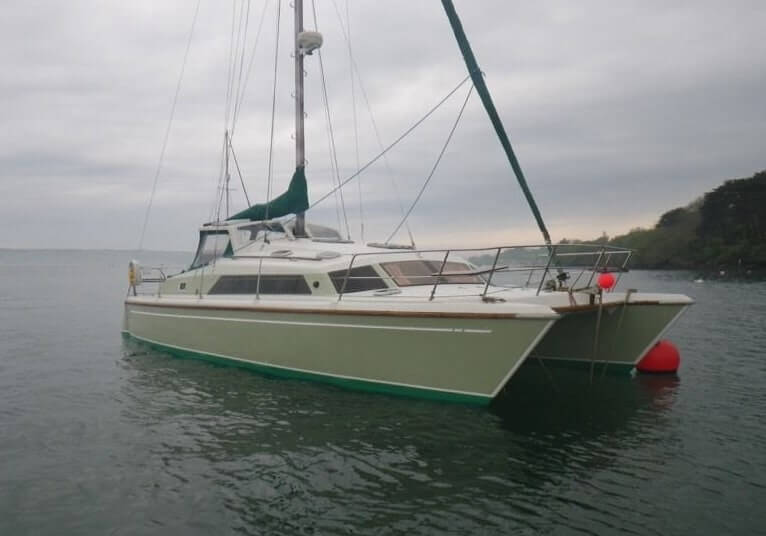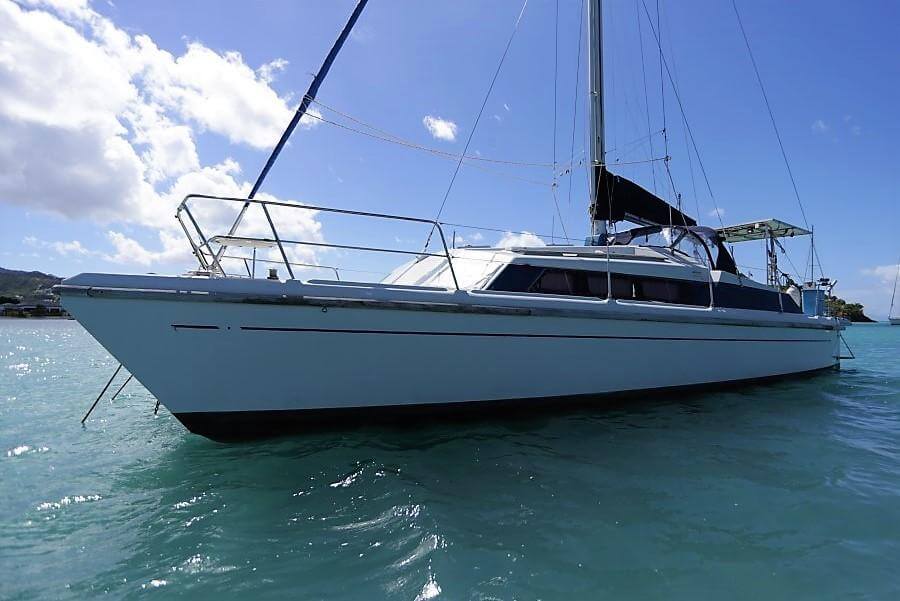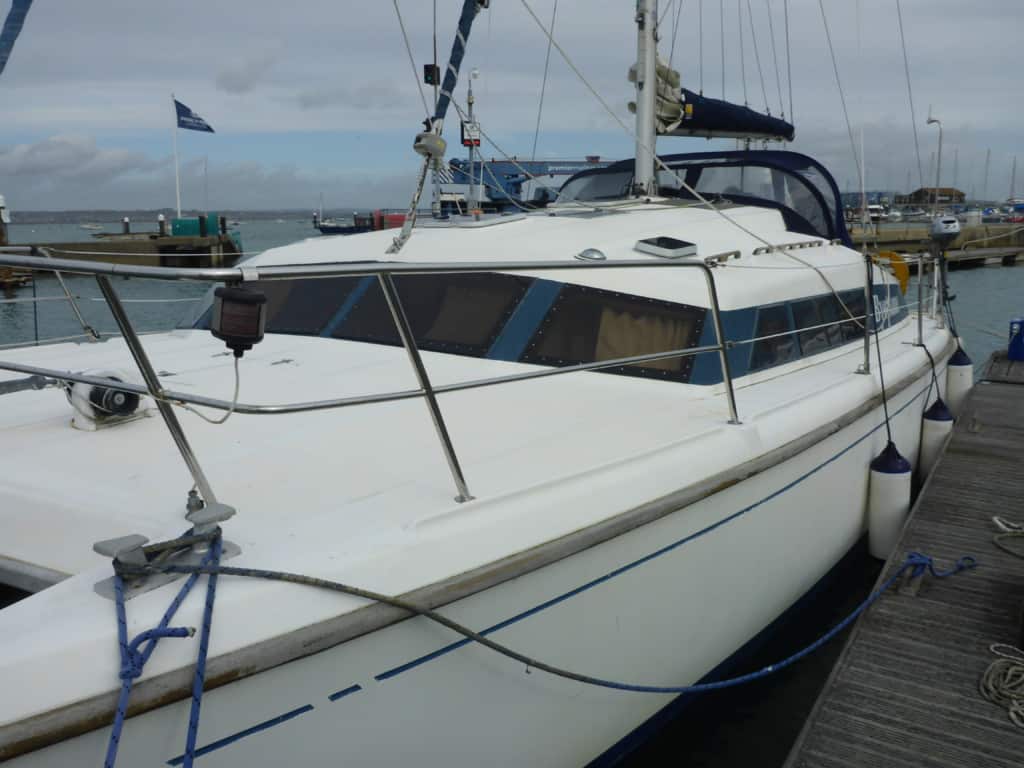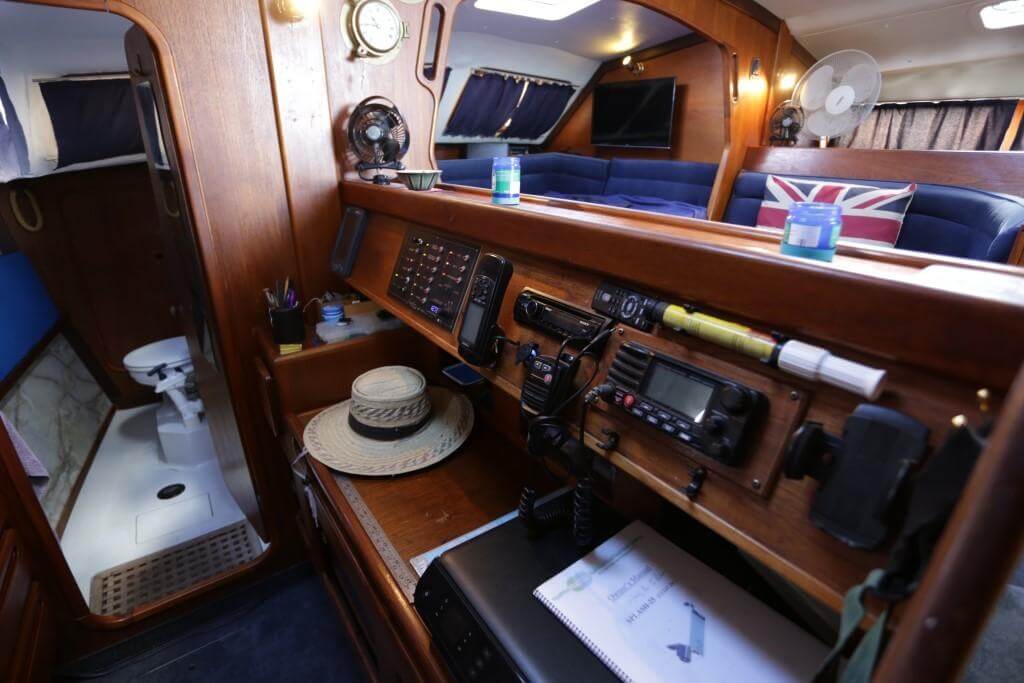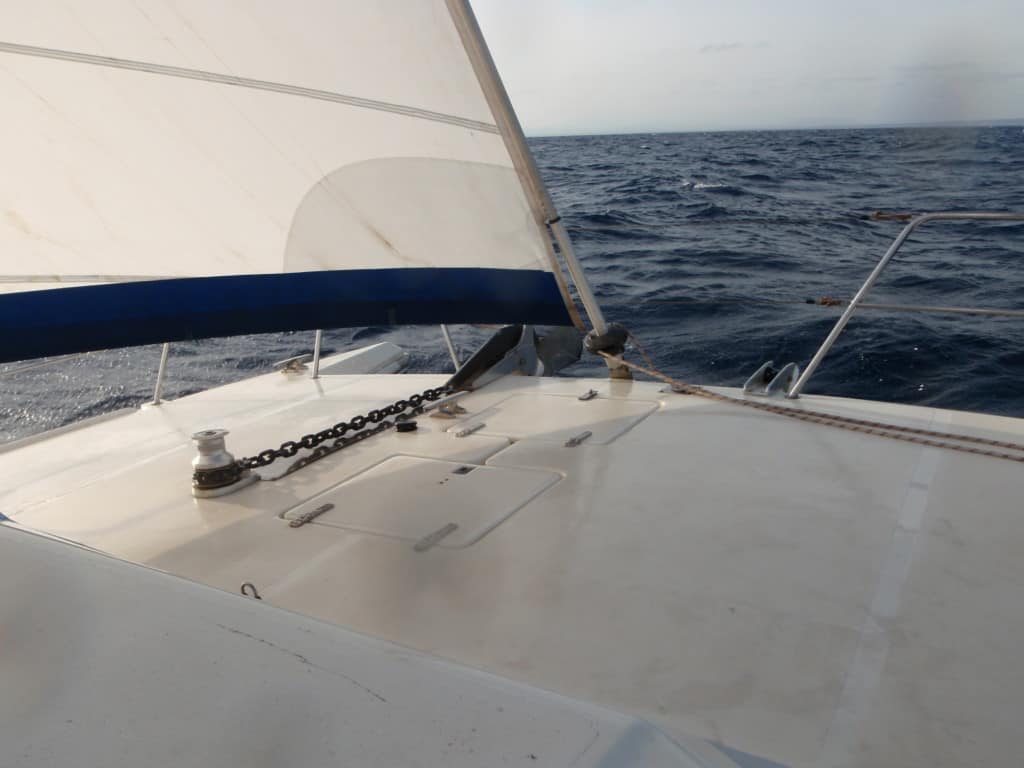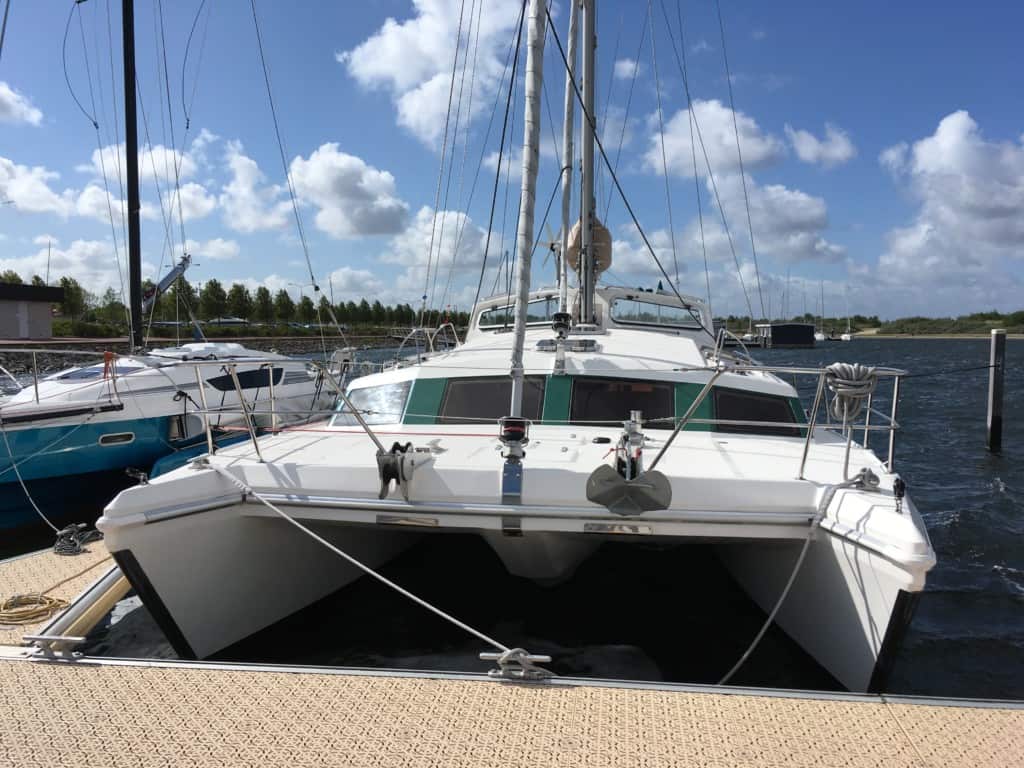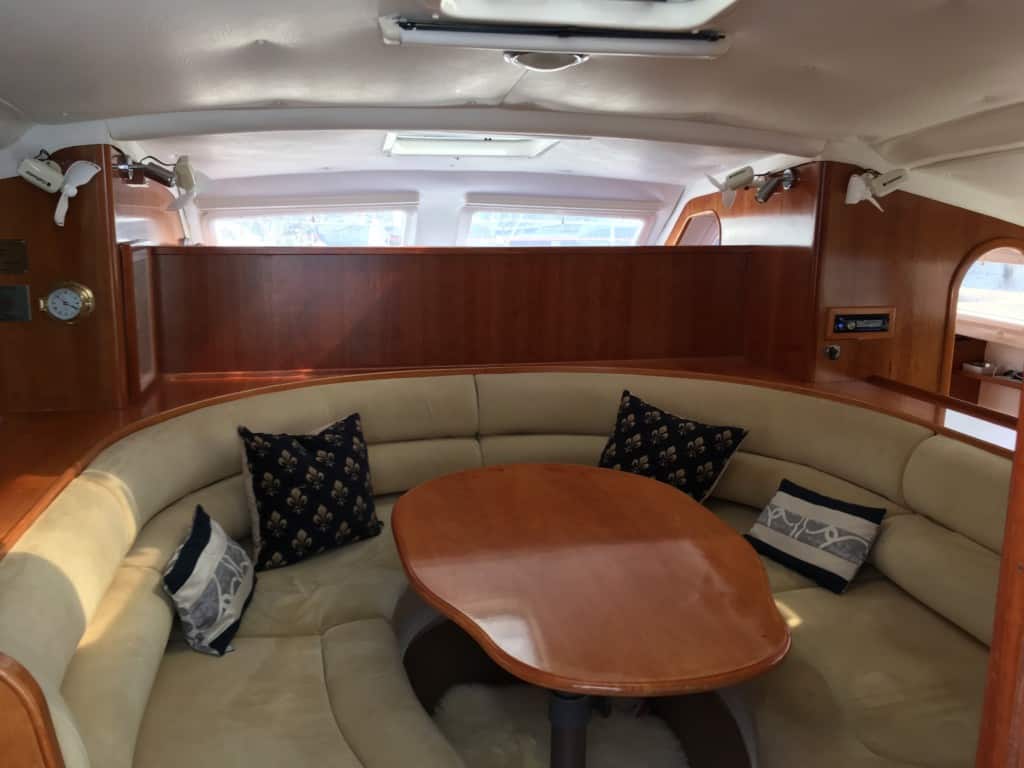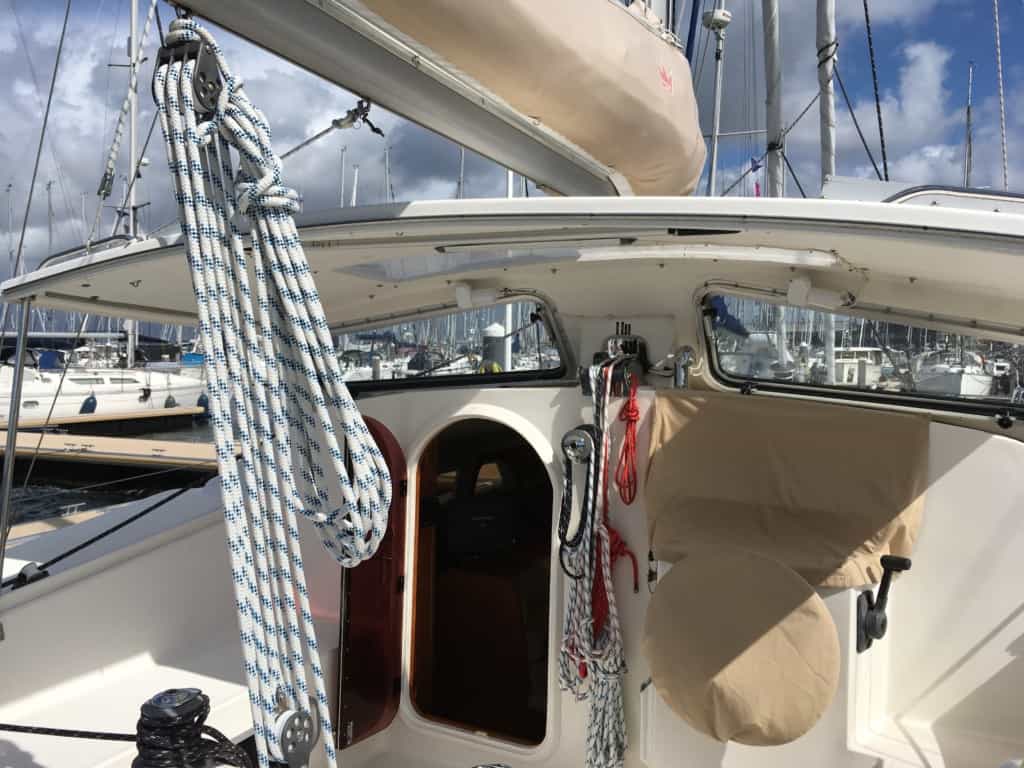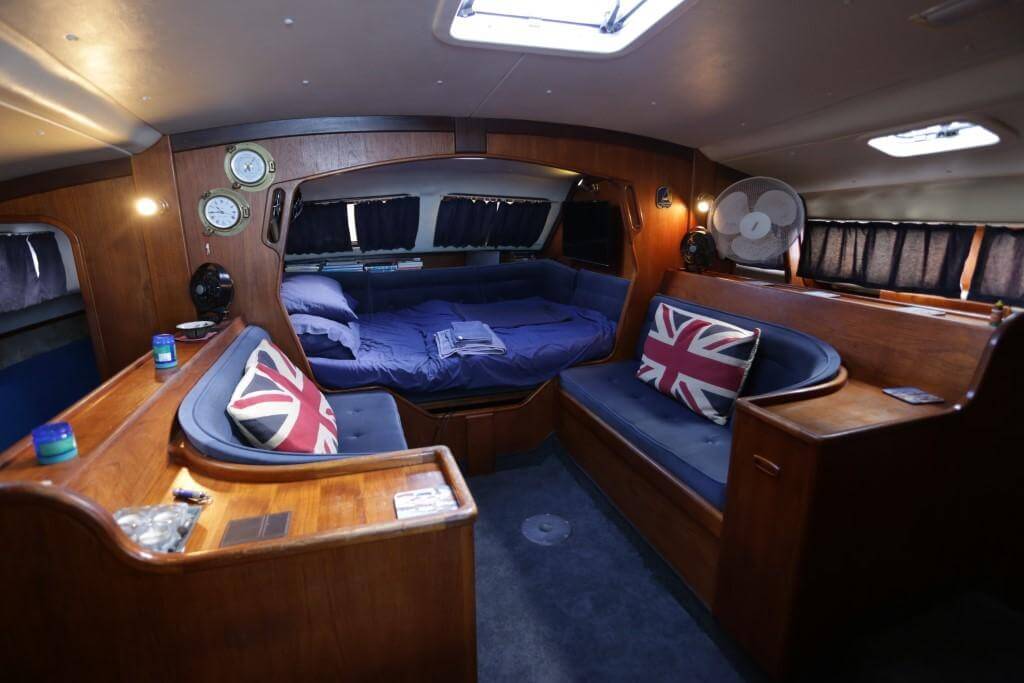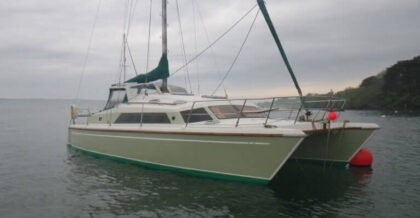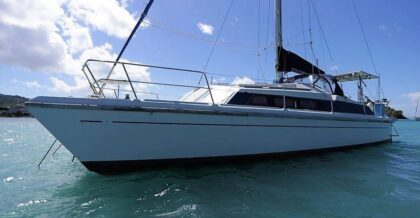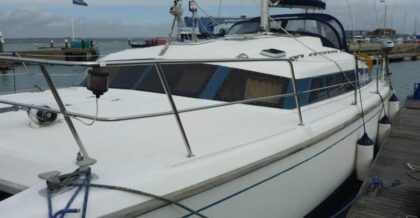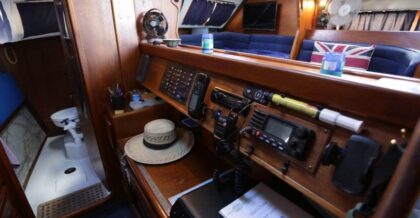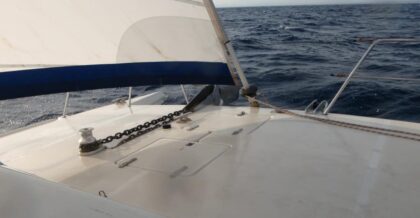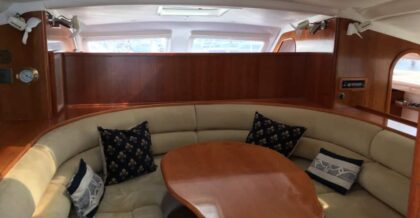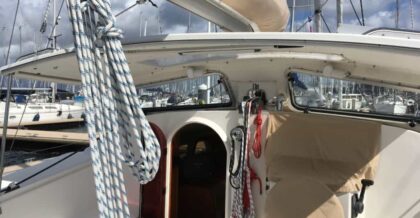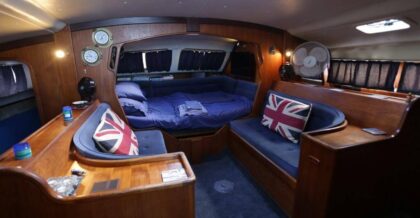 Around the World
Around the World
Which catamaran model has completed the most number of circumnavigations? Well, that’s a tricky if not impossible question to answer, but surely the Prout Snowgoose 37 can lay a claim to the record?
If you are interested in the history behind this multihull brand, head to our Prout Catamarans page where we list all of the boats that they made. If you are interested in owning one of these yachts, head to our Prout 37 Snowgoose For Sale page.
I’ve always had a soft spot for Prouts as the first catamaran I sailed on was a Prout Quest 33. The Snowgoose is her more famous sister that evolved from the earlier 35 footer
“Damn Kiwi” is a lovely example of one of these boats. Read Alan’s Prout 37 Owner’s Review for a great insight into the pros and cons of this catamaran.
The Prout Snowgoose is not a performance catamaran by any stretch of the imagination, but she sails well for her length and performs admirably in light air. She can take rough weather very well with her canoe sterns.
Mast Back, Big Genoa
Prout were the first proponents of the ‘mast-aft’ rig with a small main, large head sail and all lines & sheets leading back to the cockpit making her very easy to handle alone. You’ll need to leave the cockpit when you put up the spinnaker, but that’s about it. Interestingly, this mast aft trend has become fashionable again with everything from the Gunboat 68 to the Lagoon 46 catamaran using Prout’s old tricks.
Pros
- The Prout Snowgoose is a proven ocean crosser – a sturdy, seaworthy and affordable catamaran.
- The sail plan, with the mast set aft, is well set up for single-handed or short-handed sailing.
- She will fit into a standard marina berth – that keeps your running costs down
- If you take the mast off, you can motor down through France on the Canal du Midi.
- They are pretty manoeuvrable in the marina, especially those boats with dual aft engines.
- With flat keels and narrow beam she´s easy to haul or beach – which again saves you maintenance cost.
- Low windage with that profile.
Cons
- There is not much headroom in the salon. Once you are sat around the table, it´s fine – very cosy in fact.
- She has canoe sterns which work well dissipating wave energy from behind, but it is not so easy to get on and off the boat.
- Not the fastest catamaran on the water, but you should be able to average 6 knots
- With that covered foredeck and low bridgedeck you will get some slamming in rougher weather
- Most Snowgooses were fitted with a single engine. That makes the boat less manoeuvrable than a dual engine cat.
Head for the Canals
Snowgoose was built with mini-keels so you can dry her out in between tides to clean the hulls and her narrow beam means she is able to motor down the French canals to the Med and back again.
The single engine concept is popular with owners. While not as manoeuvrable as twin engines, you can swivel the drive through 30 degrees to get around corners. Some of the later Elite models were fitted with twin engines, I believe only around 5 37s were launched with twin engines but others have had a retro-fit. They are more manoeuvrable and you have the redundancy advantage, but it adds weight to the boat and you will lose some performance.
Watch out for Slamming
The bridge deck is pretty low compared to modern cats like a Nautitech 40 Open, and that’s because she has a centre “nacelle” like a Privilege, and yes they do suffer from slamming if you don’t load them properly, but keep the weight off the bow and the aft and she is still a very seaworthy boat, as countless owners who have crossed oceans will tell you.
These aren’t condomarans with oodles of space, and they aren’t racing cats either, but they are very well-built, strong, sea worthy and cosy boats that will deliver you across the oceans without breaking the bank.
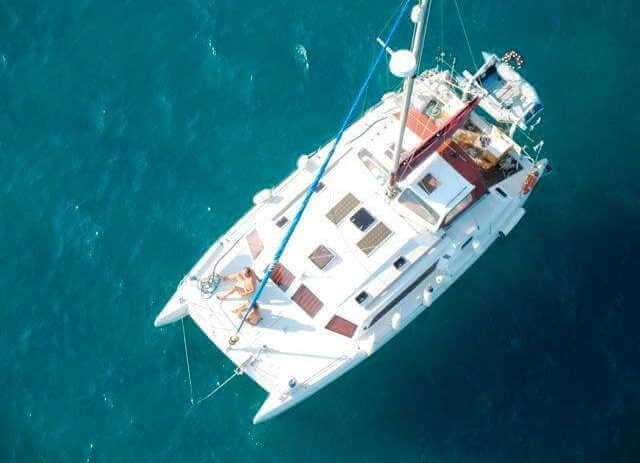 A typical reaction to this popular boat would be that it’s a real blue-water boat, famous for its rugged construction and seakindliness.
A typical reaction to this popular boat would be that it’s a real blue-water boat, famous for its rugged construction and seakindliness.
An Affordable Ocean Crosser
More than 500 boats were built (not as many as the Lagoon 380, but still) and the number that have completed circumnavigations are in the hundreds. If your budget is around 100k and you want to sail around the world, you can do it on a Snowgoose.
The Prout family were building cats in the 1950s- this was a company with a long and rich history in multihulls before they sadly went bust in 2002 following a number of turbulent years.
The Look
The Snowgoose looks a bit dumpy and dated by modern catamaran design standards, but don’t let that fool you. She has a solid bridgedeck forward (something that Bali Catamarans have taken on), and while this isn’t as fetching as having nets, it does make for a very sturdy rigid boat with plenty of working and playing space forward.
A Narrower Beam Means Lower Marina Fees
The beam is narrow compared to modern designs (the later Elite is wider) and the hulls aft don’t have sugar scoops for swimming platforms. The narrow beam means you pay standard monohull fees at most marinas: yet another saving on the running costs.
The cockpit is, shall we say, cosy, but step on board and you will quickly recognise that she is a solid, safe boat built to weather a storm.
Most Snowgoose 37s were built in the 1980s. A later model, called the Elite, has a wider beam. Both models evolved from the Snowgoose 35. She has a cutter rig with a single-spreader mast.
Construction
You can’t call the Snowgoose 37 light for her length, with a displacement of more than 5,200 tonnes, but neither is she a block of lead. The hulls with stubby fixed keels are solid fiberglass, (newer models are solid below the waterline and cored above). With the solid bridgedeck she’s very rigid and strong, and the decks are cored with balsa or other materials to keep the weight down.
The Models
The newer Elite model went into production around ’86, and it’s around a foot bigger across the beam than the standard Snowgoose, so you get more room down below, but she carries more weight and has a slightly deeper draft.
The single engine has a rotating, retractable sonic drive gear. You may come across Prout 37s with twin engines as well, in particular some of the later Elites. In either configuration, the Snowgoose is very manoeuvrable.
Up top
The cockpit is small compared to modern cats but comfy enough with a bulkhead mounted helm that has great visibility. All lines come back to the cockpit. The mainsheet traveler is aft- it’s pretty short compared to newer cats. If the weather turns, the cabin door can be quickly closed to keep it nice and dry in the saloon.
She´s Seaworthy
Although the side decks are narrow, there are plenty of handholds like the grab-rail that that you will use going forward. She feels safe, with plenty of lifelines and robust stanchions. The solid bridgedeck has two large forward lockers with plenty of storage space to keep things organised.
The majority of these cats are cutter rigged, with a furled genoa and staysail. The main is generally fully battened.
Down Below
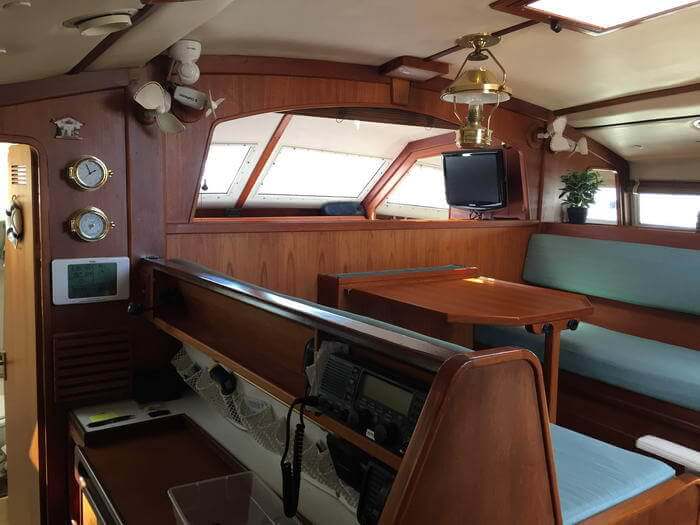 Owner´s Cabin Forward in the Nacelle.
Owner´s Cabin Forward in the Nacelle.
If you are looking at the Snowgoose 37 and her sister the Elite, you’ll be looking at 2 main layouts. The first is my favourite with a full queen berth forward (in the Privilege position) and two big double cabins aft. The forward cabin is connected to the saloon, although some owners have separated the space to various degrees to maximise privacy.
Easy Anchor Check
It’s a cool place to sleep at anchor, and you can easily check your position from your bunk. The saloon has a horseshoe sofa and a big table for socialising. It’s a really cosy space with a few friends around- it’s surprising how many people you can sit around the table. The whole feel is more cosy monohull with headroom about 5 feet, 8 inches. The solid wood finish is high quality – she has a lovely feel about her.
Plenty of Space, especially in the Elite
Forward in the starboard hull there is a changing area, storage, bookshelves and lockers. The galley is in the down position in the centre of the hull, but the port-holes are at eye level, so you can see the horizon while you’re cooking. Although she’s galley down, you’re part of the scene and connected to the saloon with your head peeping out. The fridge and freezer are under the bunk in the aft cabin. This can be a fiddle.
Each cabin aft is a double berth, with a locker, a seat and shelves. These cabins are snug but comfortable. On the port hull is a nice navigation station with a fold-down seat and traditional chart drawer. You’ll have no problems fitting your instruments and radios with the electrical switches on the forward bulkhead. There’s a single head forward that is pretty spacious.
Open Plan Option
The other option is the open plan where the horse-shoe sofa goes all the way forward instead of having the cabin. You can convert the forward part into a decent sized berth.
Under Power
Most Snowgoose 37s you’ll see will have a single engine, normally with 30 or 40 hp of power (Volvos or Yanmars generally). The fuel tank holds around 135 litres that feeds the stern drive unit (eg the Sonic Drive by Sillette). This retractable drive turns as you move the helm for greater manoeuvrability. With skegs to protect the rudder, it’s perfectly possible to beach this cat.
Later models were fitted with twin engines (the Elite) and some owners have retrofitted them.
Sailing
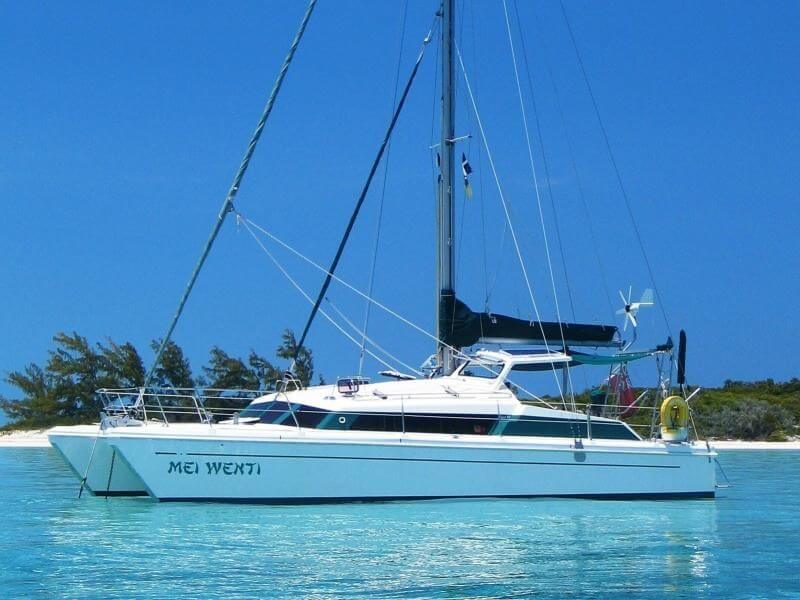 Typically, you’ll be moving along at around 6 to 7 knots in a Snowgoose- perfectly acceptable for long distance cruising. It’s an easy boat to handle, with the big genoa sucking her along- this is easy to furl away if the wind picks up.
Typically, you’ll be moving along at around 6 to 7 knots in a Snowgoose- perfectly acceptable for long distance cruising. It’s an easy boat to handle, with the big genoa sucking her along- this is easy to furl away if the wind picks up.
Beating upwind isn’t that much fun, but is it in any cat without daggerboards? She is helped on a close reach by that staysail. It is on this point of sail that you are most likely to experience bridge slam in heavy weather.
A Steady, Safe Mover
She’ll be comfortably blown along by the trade winds, however, day in and day out with not much stress involved if you set her up right. 150 miles a day is more than achievable on these boats. OK, granted, you could do more than double that on a Gunboat 68, but you could have a fleet of 50 Prouts for the same money. Or just buy one Prout and spend the rest in fancy restaurants when you get to Nanny Cay.
She’s well balanced and sails well on auto.
Prout 37 Snowgoose Brochures
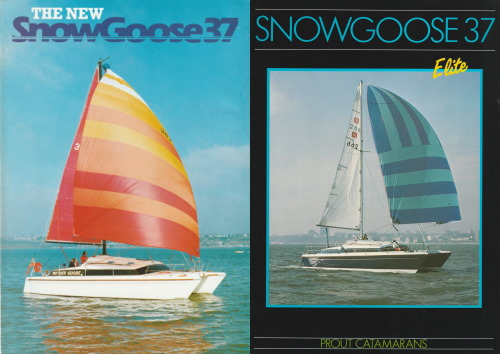 Click for the “NEW”
Click for the “NEW”
Prout Snowgoose 37 brochure.
Or click for the
Prout Snowgoose 37 Elite brochure.
With thanks to Todd Weiler who is an active member of the Prout Catamaran Owners Group on Facebook.
I love the name on the featured boat on the first brochure: Mother Goose. Looking good!
That aft port double cabin looks cosy in the picture 😉
Summary
This design might be almost 50 years old, but it has stood the test of time and the Snowgoose 37 remains a popular choice for blue-water cruisers who don’t want to spend the earth on a circumnavigation. She’s a rock solid ocean crosser with an unmatched track record.
From time to time we feature selected boats that come onto the market. Head to our Prout Snowgoose 37 For Sale page to see the latest listings.
FAQs
How much should I expect to pay for a decent Prout 37 Snowgoose?
Well, you have a whole range of options here. Do you buy a doer-upper? You might get on for €50k or less. How old? Later models, up to 2001 can approach €100k for a decent example. I would budget between €70k and €80k but make sure you leave a decent pot of funds for work. Do a comprehensive survey before you buy.
What´s the difference between a standard Snowgoose and an Elite Snowgoose?
Prout started building the Snowgoose Elite in 1986. The Elite is a foot wider than the standard Snowgoose, so there is more space down below but she´s also heavier with 2 inches more draft. The original Snowgoose has outboard rudders, whereas the Elite rudders are smaller and below the waterline. Some of the later Elites were fitted with twin aft engines.
When was the Prout Snowgoose Built?
The Prout Snowgoose 37 evolved from the 35 which was launched in 1970. By 1983 the 35 had evolved into the 37 and in 1986 they launched the Prout Snowgoose Elite. You can find Prout Snowgooses launched as late as 2001.
Technical Specification
| Water | 284 l / 75 gal |
|---|---|
| Fuel | 132 l / 35 gal |
| Displacement | 5.5 t / 12,125 lbs |
| Length | 11.28 m / 37 ft |
| Beam | 4.58 m / 15.03 ft |
| Beam (Elite) | 4.95 m / 18 ft |
| Length OA (Elite) | 11.3 m / 37 ft |
Contact Katamarans
Share your details with us and we’ll be in touch to discuss further.
"*" indicates required fields

